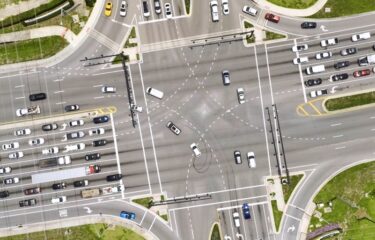PICADY
Priority Intersection Capacity and Delay
Home | Junctions & Signal Design | Junctions | PICADY
Prediction of capacities, queues, delays and accidents at isolated priority junctions. PICADY is available as the Priority Intersection Module in Junctions 11.
Click here for a summary of new features in Junctions 11, since Junctions 9.
PICADY is based on over three decades of research and development by TRL and is used for predicting capacities, queues, delays (both queueing and geometric) and accident risk at priority intersections.
Three and four-arm unsignalised give-way intersections are modelled using well-established TRL/Kimber capacity relationships (the PICADY Model), which take into account key geometries such as; road widths, visibility, the space available for traffic making an offside turn, and so on. This empirical framework intrinsically links priority junction geometry to driver behaviour and in turn to predicted capacities, queues and delays.
The PICADY model is used extensively throughout the UK and around the world. Its simple interface means that it can be used effectively by small consultancy companies.
What does PICADY module model?
- Any three or four arm priority junction, including T-junctions, crossroads and staggered crossroads
- Major roads with both single and dual carriageways may be modelled, including ghost islands and bollards
- Minor roads with single, flared and two-lane approaches
- One-way or two-way roads
- Signalised and unsignalised pedestrian crossings can be included
- Accident prediction is available for both rural and urban junction layouts
- Both drive-on-the-left and drive-on-the-right situations
Current Version: 11.1.0
System Requirements
Windows 10 or later
Supported Browsers (Portal only)
Google Chrome (latest version)
Mozilla Firefox (latest version)
Microsoft Edge (latest version)
Features in the PICADY module
- (Average) arriving vehicle delay
- Partial blocking effect by major road turning traffic
- Auto-updating summary results
- Site-specific capacity adjustments can be made for all scenarios
- Multiple geometric layouts, time periods and design years in one file
- Built-in Geometric Measuring tool assists data entry
- Point-to-point journey times
- Choice of HTML, Word and PDF outputs, including customised output
How the PICADY module works
- The program uses the geometric parameters of the junction with the traffic flows to predict queue, delay and capacity
- Additional results such as geometric delay and accident prediction are also available
- The geometric parameters and the controlling flows, split into smaller time periods, are used to calculate the capacity of each non-priority traffic stream. The queues and delays are then calculated for each time period, using time dependent queuing theory.
- The PICADY model is an empirically derived one, based on extensive data sets collected at existing junctions.





